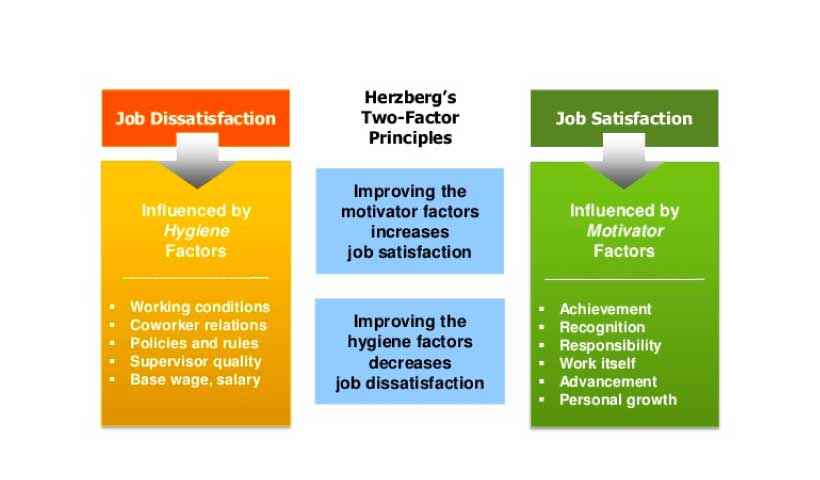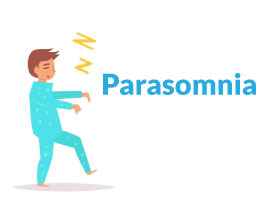Frederick Herzberg's Two-Factor Theory of Motivation, also known as the Motivation-Hygiene Theory or the Dual-Factor Theory, suggests that there are two different sets of factors that affect employee motivation and job satisfaction.
Basic component of two factor theory
The two-factor theory of motivation, also known as the Herzberg's theory, proposes that there are two basic components that contribute to job satisfaction and motivation in the workplace:
1. Hygiene factors:
These are factors that, if not fulfilled, can lead to job dissatisfaction, but their presence alone does not necessarily lead to increased motivation. Examples of hygiene factors include salary, job security, working conditions, company policies, and relationships with coworkers.
2. Motivational factors:
These are factors that directly contribute to job satisfaction and motivation. Examples of motivational factors include opportunities for growth and development, recognition for good work, meaningful and challenging work, and opportunities for advancement.
The two-factor theory suggests that managers need to focus on both hygiene factors and motivational factors to create a work environment that fosters job satisfaction and motivation among employees. While hygiene factors are necessary to prevent job dissatisfaction, they are not sufficient to motivate employees. Motivational factors, on the other hand, can lead to increased motivation and job satisfaction.
Importance of Two Factor theory
The Two-Factor Theory is a psychological theory that explains the factors that affect an individual's motivation and job satisfaction in the workplace.
The Two-Factor Theory is important because it helps managers and organizations understand the factors that motivate their employees and increase job satisfaction. By addressing both hygiene factors and motivators, managers can create a work environment that promotes employee satisfaction, productivity, and retention. Furthermore, the theory suggests that simply increasing hygiene factors such as salary or working conditions may not necessarily increase job satisfaction or motivation, but addressing motivators is more likely to do so.
Implication of Two Factor theory
The two-factor theory, also known as Herzberg's motivation-hygiene theory, proposes that there are two types of factors that influence job satisfaction and motivation in the workplace: hygiene factors and motivators.
Hygiene factors refer to the basic necessities that must be met in order for an employee to feel comfortable and satisfied in their job, such as fair compensation, job security, and a safe work environment. These factors do not necessarily lead to job satisfaction, but their absence can cause dissatisfaction.
Motivators, on the other hand, are factors that contribute to job satisfaction and intrinsic motivation, such as opportunities for growth and development, recognition and achievement, and meaningful work.
The implication of this theory is that managers and leaders in the workplace must pay attention to both hygiene factors and motivators to create a work environment that fosters job satisfaction and motivation. Simply providing good compensation and benefits may prevent dissatisfaction, but it does not necessarily lead to higher levels of motivation and engagement. In order to truly motivate employees, managers must also focus on providing opportunities for personal and professional growth, recognizing and rewarding good performance, and ensuring that employees feel their work is meaningful and fulfilling.
Overall, the Two-Factor Theory has significant implications for human resources management and can help organizations create a positive work environment that fosters employee motivation and satisfaction.
Herzberg two factor theory advantages and disadvantages
Advantages of Herzberg's Two-Factor Theory of Motivation include:
1. Employee-centric approach: The theory places the focus on employee needs and motivation, rather than simply relying on financial incentives or punishments.
2. Holistic view: The theory takes into account both the internal and external factors that contribute to job satisfaction and motivation.
3. Identifies key factors: The theory identifies specific factors that are critical for employee motivation and satisfaction, helping managers to create more effective strategies for employee engagement.
4. Long-lasting impact: By focusing on motivational factors, the theory suggests that employees will experience sustained levels of motivation and job satisfaction.
Disadvantages of Herzberg's Two-Factor Theory of Motivation include:
1. Limited scope: The theory does not take into account individual differences in employee motivation, such as personality traits or personal goals.
2. Methodological issues: The theory was based on interviews with a relatively small sample of employees and may not be representative of the wider population.
3. Overemphasis on job content: The theory places a heavy emphasis on the importance of job content and may overlook other factors, such as organizational culture or leadership.
4. Ignores the importance of financial incentives: While the theory acknowledges the importance of hygiene factors, it may not fully appreciate the role of financial incentives in motivating employees.
Overall, while Herzberg's Two-Factor Theory of Motivation has its limitations, it remains a useful framework for understanding the factors that contribute to employee motivation and job satisfaction. By taking into account both hygiene and motivational factors, managers can create a work environment that fosters sustained levels of employee engagement and productivity.
Herzberg two factor theory of motivation examples:
Here are some examples of how Herzberg's Two-Factor Theory of Motivation might apply in different workplace settings:
1. Hygiene factors: In an office setting, hygiene factors might include comfortable workstations, appropriate lighting and temperature control, flexible working hours, fair and competitive compensation, and access to appropriate tools and equipment.
2. Motivational factors: In the same office setting, motivational factors might include opportunities for learning and development, regular feedback and recognition for good work, the ability to take on challenging assignments, and a sense of autonomy and control over one's work.
3. Hygiene and motivational factors in retail: In a retail setting, hygiene factors might include a safe and secure work environment, clear policies and procedures, and competitive pay and benefits. Motivational factors might include a supportive team environment, opportunities for career advancement, and recognition for good customer service.
4. Hygiene and motivational factors in healthcare: In a healthcare setting, hygiene factors might include proper training and resources to perform tasks safely and effectively, fair compensation and benefits, and manageable workload. Motivational factors might include opportunities for professional growth, meaningful work that helps patients, and a positive workplace culture that values teamwork and collaboration.
Conclusion
By identifying and addressing both hygiene and motivational factors, managers can create a work environment that fosters employee engagement and job satisfaction, leading to improved productivity and overall success for the organization.









